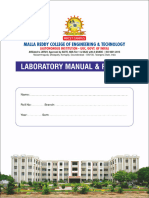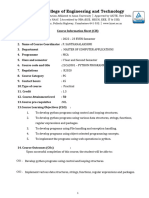0 ratings0% found this document useful (0 votes)
49 viewsIntroduction To Python: © Prof. Pitabas Mohanty, X L R I, Jamshedpur
The document provides an introduction to Python by outlining nine topics: 1) useful information sources, 2) great books, 3) using Jupyter Notebook, 4) built-in data types, 5) importing libraries, 6) logical operations, 7) using dir() to learn about objects and packages, 8) data containers like lists, tuples, dictionaries and strings, and 9) control flow including if, loops and defining functions.
Uploaded by
kkiiiddCopyright
© © All Rights Reserved
Available Formats
Download as PDF, TXT or read online on Scribd
0 ratings0% found this document useful (0 votes)
49 viewsIntroduction To Python: © Prof. Pitabas Mohanty, X L R I, Jamshedpur
The document provides an introduction to Python by outlining nine topics: 1) useful information sources, 2) great books, 3) using Jupyter Notebook, 4) built-in data types, 5) importing libraries, 6) logical operations, 7) using dir() to learn about objects and packages, 8) data containers like lists, tuples, dictionaries and strings, and 9) control flow including if, loops and defining functions.
Uploaded by
kkiiiddCopyright
© © All Rights Reserved
Available Formats
Download as PDF, TXT or read online on Scribd
You are on page 1/ 1
Introduction to Python1
1. Three useful sources of information
a. https://radimrehurek.com/data_science_python/ (nice example with code)
b. https://github.com/bulutyazilim/awesome-datascience (useful resources for Data
Science)
c. https://github.com/donnemartin/data-science-ipython-notebooks (some ipython
notebooks)
2. Great Books in Python
a. http://do1.dr-chuck.com/pythonlearn/EN_us/pythonlearn.pdf
b. https://www.greenteapress.com/thinkpython/thinkpython.pdf
c. https://media.readthedocs.org/pdf/howtothink/latest/howtothink.pdf
3. Using Jupyter Notebook
a. Keyboard shortcuts
4. Built-in data-types in Python
a. integer, float, complex, Booleans (bool), strings (str)
5. Importing libraries in Python
a. Star import (import math as *)
b. Normal import (import math)
c. Alias import (import math as m)
6. Logical operations in Python
a. and, or, nor
7. Use dir() to know details of objects and packages
8. Data Containers in Python
a. Lists (functions: len, max, min; operators: in, +, *; methods: append, extend, pop,
sort, reverse, count, insert, remove)
b. Tuples They are immutable. (methods: count, index; same functions as for list)
c. We can use tuple() and list() functions
d. Dictionaries: They are key value pairs. (functions: len, del; methods: clear, get, items,
keys, values, update
e. Strings: They are immutable
f. Sets
9. Control flow in Python
a. if function in Python
b. Loop in Python
c. Creating functions using def in Python
1
© Prof. Pitabas Mohanty, X L R I, Jamshedpur
You might also like
- PFG Credit Card Design Solution-Part 2 Gaurav Chaturvedi0% (1)PFG Credit Card Design Solution-Part 2 Gaurav Chaturvedi4 pages
- PFG Credit Card Design Solution-Gaurav ChaturvediNo ratings yetPFG Credit Card Design Solution-Gaurav Chaturvedi6 pages
- R22 - Problem Solving Using Python Programming LabNo ratings yetR22 - Problem Solving Using Python Programming Lab70 pages
- Project Report Industrial Training: DAV Institute of Engineering & Technology, JalandharNo ratings yetProject Report Industrial Training: DAV Institute of Engineering & Technology, Jalandhar24 pages
- Top Python Interview Questions and Answers100% (1)Top Python Interview Questions and Answers14 pages
- 1 Unit Assignment_CS-205_Python_ProgrammingNo ratings yet1 Unit Assignment_CS-205_Python_Programming7 pages
- Syllabus - Fundamentals of Python ProgrammingNo ratings yetSyllabus - Fundamentals of Python Programming4 pages
- MSG - 139 - 601031 - TSD1 - PWS - STD - VI - AI - L4 - Artificial Intelligence With Python - 2023 - 24 - AnswerKeyNo ratings yetMSG - 139 - 601031 - TSD1 - PWS - STD - VI - AI - L4 - Artificial Intelligence With Python - 2023 - 24 - AnswerKey9 pages
- Lesson 03 3.01 Python Libraries For Data ScienceNo ratings yetLesson 03 3.01 Python Libraries For Data Science79 pages
- Object Oriented Programming: Numeriano B. Aguado John Ren G. SantosNo ratings yetObject Oriented Programming: Numeriano B. Aguado John Ren G. Santos75 pages
- PP-Lab Internal Exam Question Viva-Voce 2023-08-05No ratings yetPP-Lab Internal Exam Question Viva-Voce 2023-08-052 pages
- Data Structures Foundation-2021 Batch - Class NotesNo ratings yetData Structures Foundation-2021 Batch - Class Notes208 pages
- Mastering Python: A Comprehensive Guide for Beginners and ExpertsFrom EverandMastering Python: A Comprehensive Guide for Beginners and ExpertsNo ratings yet
- Mastering Python Programming: A Comprehensive Guide: The IT CollectionFrom EverandMastering Python Programming: A Comprehensive Guide: The IT Collection5/5 (1)
- Maharashtra Metro Rail Corporation Limited Pune Metro Rail Project Bid Documents FORNo ratings yetMaharashtra Metro Rail Corporation Limited Pune Metro Rail Project Bid Documents FOR143 pages
- Sulabh Shauchalaya Pre Purchase ProjectNo ratings yetSulabh Shauchalaya Pre Purchase Project67 pages
- Spss HR Analytics Assignment Employee Satisfaction 1 20162164 - Part 1No ratings yetSpss HR Analytics Assignment Employee Satisfaction 1 20162164 - Part 113 pages





































































